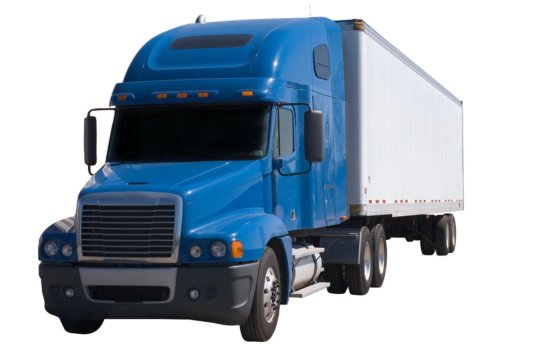 Nearly 70 percent of all freight transported throughout the U.S. is transported by truck, mostly through the services of around 1.2 million trucking companies. An estimated 15.5 million commercial trucks are in operation in the United States, including about two-million semi-trucks. These trucks log about 433 billion miles a year, hauling around $671 billion worth of goods from within the country and another several hundred billion from Canada and Mexico. It’s safe to say that our nation’s economy and our daily lives are heavily affected by the trucking industry. If you or a loved one's life has already been negatively impacted from a trucking related accident don't hesitate to talk to a truck accident attorney for your recovery options.
Nearly 70 percent of all freight transported throughout the U.S. is transported by truck, mostly through the services of around 1.2 million trucking companies. An estimated 15.5 million commercial trucks are in operation in the United States, including about two-million semi-trucks. These trucks log about 433 billion miles a year, hauling around $671 billion worth of goods from within the country and another several hundred billion from Canada and Mexico. It’s safe to say that our nation’s economy and our daily lives are heavily affected by the trucking industry. If you or a loved one's life has already been negatively impacted from a trucking related accident don't hesitate to talk to a truck accident attorney for your recovery options.
When people think of commercial trucks, they often only think about a specific type of truck—such as a dump truck or a semi-truck. In reality, there are several different types of trucks, classified by whether they carry cargo or passengers, as well as by the weight of the vehicles.
Most commercial trucks are regulated by the Federal Motor Carrier Safety Administration (FMSCA), which regulates such things as physical exams and screenings for truckers who are taking drugs, oversight of hours worked, proper loading of cargo, blind spots on the trucks, and much more. Here is a listing of some of the commercial trucks most commonly seen on the road.
Buses
Buses can come with nine to 15 seats, including the driver, or with 16 or more seats, including the driver, and this category includes school buses, shuttle buses, tour buses, and metro buses. However, other vehicles designed to carry nine or more passengers are also classified as a bus, including limousines or vans. interstate commerce regulations may govern passenger carriers that transport passengers across state lines or from the United States to a foreign country such as Canada or Mexico.
How much regulation is provided also is determined by whether the bus is private or for hire. A bus is considered for-hire if the passenger carrier receives compensation for transporting the passengers.
Providers of for-hire transportation do not have to make their services available to the public, and for-hire trips may include a combination of paying and non-paying passengers. To be considered private transport, the passenger carrier cannot accept any payment, including gifts, donations, gas money, etc.
Single Unit Vehicles With Two Axles and Six Tires
This category pertains to box-style delivery or moving trucks in which the vehicle and its storage compartment are all one unit. Standard fire engines also fit in this classification, as do smaller flatbed-style vehicles used for transporting lumber. An axle is a central shaft that runs through the center of a wheel. A two-axle vehicle generally has a single wheel on each end of the front axle as well as two wheels on each end of the rear axle.
Single Unit Vehicles With Three or More Axles
Like the 2-axle variety, single unit delivery-style trucks may also have additional axles. Examples of single unit vehicles with three or more axles may include dump trucks with open beds in the back, cement trucks, or garbage trucks.
Single Unit Truck Pulling a Trailer
 This refers to a single unit truck such as those listed above that is also pulling either a flatbed or box trailer that attaches and detaches from the truck.
This refers to a single unit truck such as those listed above that is also pulling either a flatbed or box trailer that attaches and detaches from the truck.
Truck Tractor (Bobtail)
A truck tractor, also known as a bobtail, is the truck part of the semi-truck without the trailer attached. The truck tractor houses the power unit needed to haul heavily-loaded trailers but has no cargo carrying capability without the trailer attached. Often trucks don’t have attached trailers.
Tractor Semi Trailer
This is commonly known as a semi-truck, big rig, or 18-wheeler. The combination includes a tractor, as well as a semi trailer used for transporting a large quantity of goods in a trailer that can be detached from the tractor. In addition to dry goods, tractor semi trailers may also haul hazardous materials such as gasoline in a tube-shaped trailer known as a tanker, may pull a trailer used to transport other vehicles, or may have a refrigerated trailer used for transporting perishable items.
Multiple trailers can be pulled behind one tractor and these are referred to as:
- Truck tractor/double: This refers to a truck tractor that is pulling two tandem trailers that are attached.
- Truck tractor/triple: This combination features a truck tractor as well as three tandem trailers attached.
Vehicle Classifications
All vehicles are classified according to weight and intended purpose, with classifications also being used to determine what type of license is required to operate a certain vehicle. The classifications are based on the vehicle’s gross vehicle weight rating (GVWR), which is the maximum weight of the truck plus the weight of fuel, cargo, passengers, and the trailer tongue.
The classifications follow:
- Light trucks, classes 1-3: These vehicles have a GVWR of 14,001 - 16,000 pounds and are generally non-commercial vehicles, including minivans, cargo vans, SUVs, and pickup trucks.
- Medium trucks, class 4: This category includes trucks with a GVWR between 16,000 and 19,500 pounds such as the Ford F-450, as well as many smaller box trucks and delivery trucks.
- Medium trucks, class 5: This class may still carry some very large non-commercial trucks, but also consists of vehicles such as larger delivery trucks, bucket trucks, or cherry pickers.
- Medium trucks, class 6: With a GVWR of 19,501 to 26,000 pounds, this class includes many single axle trucks, beverage trucks, and school buses. This type of truck requires a CDL to operate.
- Heavy trucks, class 7: Class 7 trucks have a GVWR of 26,001 to 33,000 pounds. Common examples of class 7 trucks are street sweepers, city transit buses, and garbage trucks.
- Heavy trucks, class 8: With a GVWR of 33,001 pounds and more. This category includes semi-trucks as well as cement and dump trucks.
If you were injured or lost a loved one due to a truck accident, consult an experienced truck accident attorney. Most truck accident lawyers offer a free case review where you can ask questions and get more information.



